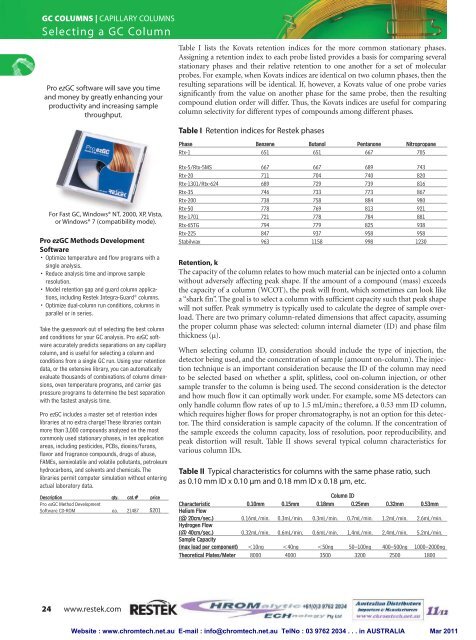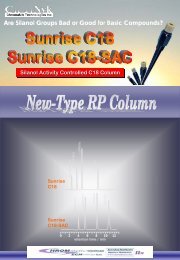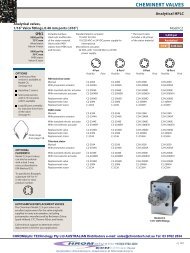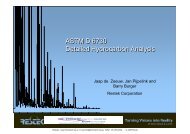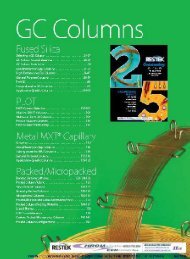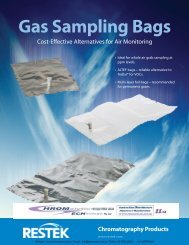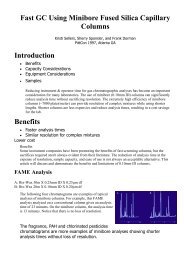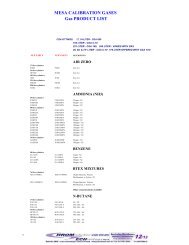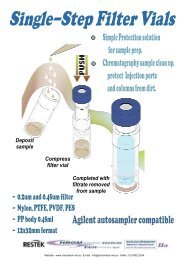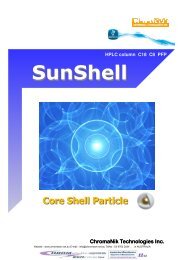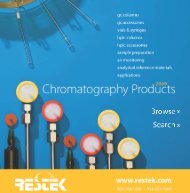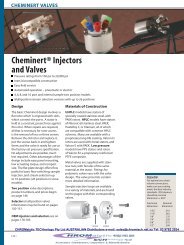Create successful ePaper yourself
Turn your PDF publications into a flip-book with our unique Google optimized e-Paper software.
<strong>GC</strong> COLUMNS | CAPILLARY COLUMNS<br />
Selecting a <strong>GC</strong> Column<br />
Pro ez<strong>GC</strong> software will save you time<br />
and money by greatly enhancing your<br />
productivity and increasing sample<br />
throughput.<br />
Table I lists the Kovats retention indices for the more common stationary phases.<br />
Assigning a retention index to each probe listed provides a basis for comparing several<br />
stationary phases and their relative retention to one another for a set of molecular<br />
probes. For example, when Kovats indices are identical on two column phases, then the<br />
resulting separations will be identical. If, however, a Kovats value of one probe varies<br />
significantly from the value on another phase for the same probe, then the resulting<br />
compound elution order will differ. Thus, the Kovats indices are useful for comparing<br />
column selectivity for different types of compounds among different phases.<br />
Table I Retention indices for Restek phases<br />
Phase Benzene Butanol Pentanone Nitropropane<br />
Rtx-1 651 651 667 705<br />
For Fast <strong>GC</strong>, Windows® NT, 2000, XP, Vista,<br />
or Windows® 7 (compatibility mode).<br />
Pro ez<strong>GC</strong> Methods Development<br />
Software<br />
• Optimize temperature and flow programs with a<br />
single analysis.<br />
• Reduce analysis time and improve sample<br />
resolution.<br />
• Model retention gap and guard column applications,<br />
including Restek Integra-Guard ® columns.<br />
• Optimize dual-column run conditions, columns in<br />
parallel or in series.<br />
Take the guesswork out of selecting the best column<br />
and conditions for your <strong>GC</strong> analysis. Pro ez<strong>GC</strong> software<br />
accurately predicts separations on any capillary<br />
column, and is useful for selecting a column and<br />
conditions from a single <strong>GC</strong> run. Using your retention<br />
data, or the extensive library, you can automatically<br />
evaluate thousands of combinations of column dimensions,<br />
oven temperature programs, and carrier gas<br />
pressure programs to determine the best separation<br />
with the fastest analysis time.<br />
Pro ez<strong>GC</strong> includes a master set of retention index<br />
libraries at no extra charge! These libraries contain<br />
more than 3,000 compounds analyzed on the most<br />
commonly used stationary phases, in ten application<br />
areas, including pesticides, PCBs, dioxins/furans,<br />
flavor and fragrance compounds, drugs of abuse,<br />
FAMEs, semivolatile and volatile pollutants, petroleum<br />
hydrocarbons, and solvents and chemicals. The<br />
libraries permit computer simulation without entering<br />
actual laboratory data.<br />
Description qty. cat.# price<br />
Pro ez<strong>GC</strong> Method Development<br />
Software CD-ROM ea. 21487 $201<br />
Rtx-5/Rtx-5MS 667 667 689 743<br />
Rtx-20 711 704 740 820<br />
Rtx-1301/Rtx-624 689 729 739 816<br />
Rtx-35 746 733 773 867<br />
Rtx-200 738 758 884 980<br />
Rtx-50 778 769 813 921<br />
Rtx-1701 721 778 784 881<br />
Rtx-65TG 794 779 825 938<br />
Rtx-225 847 937 958 958<br />
Stabilwax 963 1158 998 1230<br />
Retention, k<br />
The capacity of the column relates to how much material can be injected onto a column<br />
without adversely affecting peak shape. If the amount of a compound (mass) exceeds<br />
the capacity of a column (WCOT), the peak will front, which sometimes can look like<br />
a “shark fin”. The goal is to select a column with sufficient capacity such that peak shape<br />
will not suffer. Peak symmetry is typically used to calculate the degree of sample overload.<br />
There are two primary column-related dimensions that affect capacity, assuming<br />
the proper column phase was selected: column internal diameter (ID) and phase film<br />
thickness (µ).<br />
When selecting column ID, consideration should include the type of injection, the<br />
detector being used, and the concentration of sample (amount on-column). The injection<br />
technique is an important consideration because the ID of the column may need<br />
to be selected based on whether a split, splitless, cool on-column injection, or other<br />
sample transfer to the column is being used. The second consideration is the detector<br />
and how much flow it can optimally work under. For example, some MS detectors can<br />
only handle column flow rates of up to 1.5 mL/min.; therefore, a 0.53 mm ID column,<br />
which requires higher flows for proper chromatography, is not an option for this detector.<br />
The third consideration is sample capacity of the column. If the concentration of<br />
the sample exceeds the column capacity, loss of resolution, poor reproducibility, and<br />
peak distortion will result. Table II shows several typical column characteristics for<br />
various column IDs.<br />
Table II Typical characteristics for columns with the same phase ratio, such<br />
as 0.10 mm ID x 0.10 μm and 0.18 mm ID x 0.18 μm, etc.<br />
Column ID<br />
Characteristic 0.10mm 0.15mm 0.18mm 0.25mm 0.32mm 0.53mm<br />
Helium Flow<br />
(@ 20cm/sec.) 0.16mL/min. 0.3mL/min. 0.3mL/min. 0.7mL/min. 1.2mL/min. 2.6mL/min.<br />
Hydrogen Flow<br />
(@ 40cm/sec.) 0.32mL/min. 0.6mL/min. 0.6mL/min. 1.4mL/min. 2.4mL/min. 5.2mL/min.<br />
Sample Capacity<br />
(max load per component)


